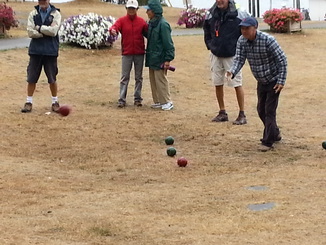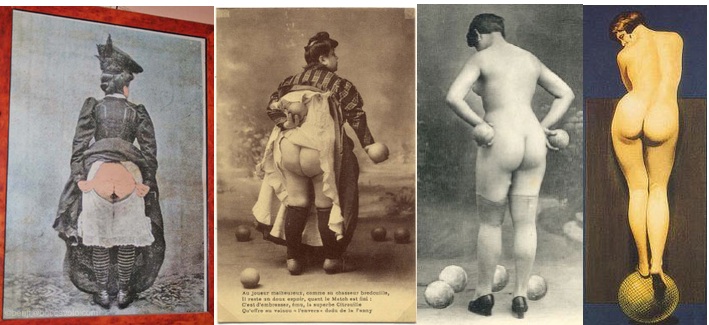Well the 2015 Fall Rendezvous was definitely exciting! Summer Snow had a spectacular sail through satellite channel, Sansum Narrows and then all the way to Telegraph Harbour in the sunshine, with a rising following breeze and tide in our favour. Then we all got to experience 63 knot gusts at the dock on Saturday accompanied by rain, hail and bursts of sunshine. But of course one of the highlights was the tournament of the Underhanded Game..... I speak of course of the annual Bocce tournament. The most consistent rule in Bocce is that the ball must be bowled or thrown underhand as shown below by Jeff.

However, in this underhanded contest many other rules and guidelines vary..... so I undertook to find out if there were in fact one set of rules. But before exploring the rules, some history. The word “bocce” is a plural of the word “boccia” meaning ball in Italian. "Volo," as it is also called by the Italians, derives it’s name from the Italian verb “volare,” meaning “to fly” and refers to the manner of throwing a ball through the air in the attempt of striking away an opponents ball. The French refer to the sport as "Boule Lyonnaise." With this info as background, and armed with the experience of playing the underhanded game with many different rules I began to investigate just how many "Official" sets of rules there may be. Quite a task.... which I subsequently abandoned! Apparently there are as many rules as their are associations who play the game. However, what I did find is that there are at least 5 main types of Bocce (thats excluding variants that are actually Boules or lawn bowling or some other thing). These are 1. Indoor Bocce (with a defined court, 2. Outdoor Bocce (with a defined court or playing surface (see below).
Geometry of a formal Bocce
True bocce courts correlate to the ancient "golden ratio"a.k.a"Phi" = 1.6 = 8 / 5 = :
Court length = 27.50 m, maximum width = 4 m, K = (27.5 / 4) = 6.8534, which is exactly .
For the minimum width = 2.5 m, the ratio is K = (27.5 / 2.5) = 11, i.e. .
The ratio between minimum and maximum width is 4 / 2.5 = 8 / 5 = 1.6 = .
Geometry of a formal Bocce
True bocce courts correlate to the ancient "golden ratio"a.k.a"Phi" = 1.6 = 8 / 5 = :
Court length = 27.50 m, maximum width = 4 m, K = (27.5 / 4) = 6.8534, which is exactly .
For the minimum width = 2.5 m, the ratio is K = (27.5 / 2.5) = 11, i.e. .
The ratio between minimum and maximum width is 4 / 2.5 = 8 / 5 = 1.6 = .
3. Outdoor Bocce with a playing surface defined by ropes (flexible), 4. Beach Bocce, and 5. a version that is similar to Boules in that you do not define a playing area but instead restart the game in a 1 metre circle positioned around the former location of the Jack or Palino. In each case there can be 3 types of Bocce played (Punto, Raffa, Volo) or some combination thereof.... Punto is complicated.... All the collisions of balls are valid unless any ball travels more than 70 cm... then they are not). Volo is high tosses where you have to call the target and you must land within .5 metres of the target before striking it. In Raffa the ball is tossed a minimum distance and then rolls to a called target where it must land within 13 cm of the target ). Yes really.... but most people don't seem to follow the rules unless its an official tournament where the rules are serious. I especially liked the rules of the The Memphis Italian-American Society and Bocce Club rules and regulations which were defined in the 1870’s. They basically stated they did not like the stringent rules and made up their own. I believe the CSWest club should continue in this tradition. A couple of interesting potential additions to our current rules follow....
Leaners Etc:
In some rules there are extra points awarded for balls that are touching the Pallino, in some cases 2 points in another case a ball touching the Pallino is worth 5 points, a ball within a ball diameter but not touching is worth 3 points and all other balls are worth 1. If both teams have a ball touching the Pallino then no points are awarded or maybe they are. s
See http://www.beachbocce.com/rules/.
The Yellow Card:
There were some folks who laughed when I thought Keith should get a yellow card but .... In Bocce you can get yellow carded for kicking any ball... if you get 2 yellow cards in a match you are red carded and ejected.... you then lose your balls. See http://www.boccevolo.com/about/ch4.html.
The Fanny Award:
"Fanny" began on the "plateau de la Croix-Rousse" between 1860 et 1870 in Lyon, France. She was not known as a player, but rather a girl who would expose her backside to the losers of the match. The losers would then be obliged to kiss it in defeat! Today it is common for clubs to have a picture or sculpture of Fanny (see below), thus providing something to kiss for anyone who loses without scoring a single point. I believe this may have happened in this years tournament.
Leaners Etc:
In some rules there are extra points awarded for balls that are touching the Pallino, in some cases 2 points in another case a ball touching the Pallino is worth 5 points, a ball within a ball diameter but not touching is worth 3 points and all other balls are worth 1. If both teams have a ball touching the Pallino then no points are awarded or maybe they are. s
See http://www.beachbocce.com/rules/.
The Yellow Card:
There were some folks who laughed when I thought Keith should get a yellow card but .... In Bocce you can get yellow carded for kicking any ball... if you get 2 yellow cards in a match you are red carded and ejected.... you then lose your balls. See http://www.boccevolo.com/about/ch4.html.
The Fanny Award:
"Fanny" began on the "plateau de la Croix-Rousse" between 1860 et 1870 in Lyon, France. She was not known as a player, but rather a girl who would expose her backside to the losers of the match. The losers would then be obliged to kiss it in defeat! Today it is common for clubs to have a picture or sculpture of Fanny (see below), thus providing something to kiss for anyone who loses without scoring a single point. I believe this may have happened in this years tournament.
So that brings us to an end ..... of another blog.... But I leave you all with a question. If the spectators of the game are struck by lightning because they are standing under a tree in a thunderstorm.... Do we call the game of Bocce or continue to play.






